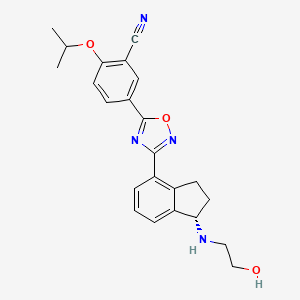



API Suppliers

US DMFs Filed

CEP/COS Certifications
0

JDMFs Filed
0
Other Certificates
0
Other Suppliers

USA (Orange Book)

Europe
0

Canada
0

Australia

South Africa
0
Uploaded Dossiers
U.S. Medicaid
Annual Reports
0
0


1. Rpc1063
1. 1306760-87-1
2. Rpc1063
3. Rpc-1063
4. Ozanimod (rpc1063)
5. (s)-5-(3-(1-((2-hydroxyethyl)amino)-2,3-dihydro-1h-inden-4-yl)-1,2,4-oxadiazol-5-yl)-2-isopropoxybenzonitrile
6. Z80293urpv
7. Zeposia
8. Unii-z80293urpv
9. Benzonitrile, 5-(3-((1s)-2,3-dihydro-1-((2-hydroxyethyl)amino)-1h-inden-4-yl)-1,2,4-oxadiazol-5-yl)-2-(1-methylethoxy)-
10. Ozanimod [inn]
11. 5-[3-[(1~{s})-1-(2-hydroxyethylamino)-2,3-dihydro-1~{h}-inden-4-yl]-1,2,4-oxadiazol-5-yl]-2-propan-2-yloxy-benzenecarbonitrile
12. Benzonitrile, 5-[3-[(1s)-2,3-dihydro-1-[(2-hydroxyethyl)amino]-1h-inden-4-yl]-1,2,4-oxadiazol-5-yl]-2-(1-methylethoxy)-
13. Ozanimod [usan:inn]
14. 5-[3-[(1s)-1-(2-hydroxyethylamino)-2,3-dihydro-1h-inden-4-yl]-1,2,4-oxadiazol-5-yl]-2-propan-2-yloxybenzonitrile
15. Rpc 1063
16. Ozanimod [usan]
17. Ozanimod; Rpc1063
18. Ozanimod (usan/inn)
19. Ozanimod [mi]
20. Ozanimod [who-dd]
21. Gtpl8709
22. Schembl2195490
23. Chembl3707247
24. Amy3373
25. Dtxsid501026488
26. Bcp16513
27. Ex-a1316
28. Rpc1063:rpc-1063
29. Bdbm50507186
30. Mfcd28386168
31. S7952
32. Akos026674086
33. Zinc116109867
34. Ccg-268695
35. Cs-5070
36. Db12612
37. Ac-29883
38. As-75063
39. Hy-12288
40. J3.612.016i
41. D10968
42. P14657
43. Q21098986
44. 5-{3-[(1s)-1-[(2-hydroxyethyl)amino]-2,3-dihydro-1h-inden-4-yl]-1,2,4-oxadiazol-5-yl}-2-(propan-2-yloxy)benzonitrile
45. Jeu
| Molecular Weight | 404.5 g/mol |
|---|---|
| Molecular Formula | C23H24N4O3 |
| XLogP3 | 3.1 |
| Hydrogen Bond Donor Count | 2 |
| Hydrogen Bond Acceptor Count | 7 |
| Rotatable Bond Count | 7 |
| Exact Mass | 404.18484064 g/mol |
| Monoisotopic Mass | 404.18484064 g/mol |
| Topological Polar Surface Area | 104 Ų |
| Heavy Atom Count | 30 |
| Formal Charge | 0 |
| Complexity | 609 |
| Isotope Atom Count | 0 |
| Defined Atom Stereocenter Count | 1 |
| Undefined Atom Stereocenter Count | 0 |
| Defined Bond Stereocenter Count | 0 |
| Undefined Bond Stereocenter Count | 0 |
| Covalently Bonded Unit Count | 1 |
Ozanimod is indicated for adults in the treatment of relapsing forms of MS, which may include relapsing-remitting disease, clinically isolated syndrome, and active secondary progressive MS.
FDA Label
Multiple sclerosis
- Zeposia is indicated for the treatment of adult patients with relapsing remitting multiple sclerosis (RRMS) with active disease as defined by clinical or imaging features.
Ulcerative colitis
- Zeposia is indicated for the treatment of adult patients with moderately to severely active ulcerative colitis (UC) who have had an inadequate response, lost response, or were intolerant to either conventional therapy or a biologic agent.
Ozanimod reduces circulating lymphocytes that cause the neuroinflammation associated with MS, reducing debilitating symptoms and, possibly, disease progression. During clinical trials, ozanimod reduced MS-associated brain volume loss in several regions. Ozanimod causes the sequestration of peripheral lymphocytes, reducing circulating lymphocytes in the gastrointestinal tract.
Sphingosine 1 Phosphate Receptor Modulators
Agents that affect the function of G-protein coupled SPHINGOSINE 1-PHOSPHATE RECEPTORS. Their binding to the receptors blocks lymphocyte migration and are often used as IMMUNOSUPPRESSANTS. (See all compounds classified as Sphingosine 1 Phosphate Receptor Modulators.)
L04AA38
L - Antineoplastic and immunomodulating agents
L04 - Immunosuppressants
L04A - Immunosuppressants
L04AA - Selective immunosuppressants
L04AA38 - Ozanimod
Absorption
Ozanimod is absorbed in the gastrointestinal tract after oral administration. The Cmax of ozanimod is 0.244 ng/mL and is achieved at 6 to 8 hours after administration, reaching steady-state at about 102 hours after administration. The AUC is 4.46 ng*h/mL. Its delayed absorption reduces effects that may occur after the first dose, such as heart rate changes. The peak plasma concentration of ozanimod is low due to a high volume of distribution.
Route of Elimination
The kidneys are not a major source of elimination for ozanimod. After a 0.92 mg dose of radiolabeled ozanimod was administered, about 26% of the labeled drug was accounted for in the urine and 37 % in the feces, mainly in the form of inactive metabolites.
Volume of Distribution
The average volume of distribution of ozanimod is 5590L. Another reference mentions a volume of distribution ranging from 73-101 L/kg. This drug crosses the blood-brain barrier.
Clearance
The mean apparent oral clearance of ozanimod, according to prescribing information, is 192 L/h. Another reference indicates an oral clearance of 233 L/h.
Ozanimod has two major active metabolites CC112273 and CC1084037 and minor active metabolites such as RP101988, RP101075, and RP101509, which target the S1P1 and S1P5 receptors. The enzymes involved in the metabolism of ozanimod include ALDH/ADH, NAT-2, Monoamine Oxidase B, and AKR 1C1/1C2. After metabolism, ozanimod (6%), CC112273 (73%), and CC1084037 (15%) are accounted for in the circulation.
The half-life of ozanimod ranges from 17-21 hours.
Sphingosine1phosphate (S1P) is an important phospholipid that binds to various Gproteincoupled receptor subtypes, which can be identified as S1P15R. S1P and the receptors it binds to perform regular functions in the immune, cardiovascular, pulmonary, and nervous system. S1P can be expressed ubiquitously, playing an important role in regulating inflammation. S1P1R, S1P2R, and S1P3R receptors can be found in the cardiovascular, immune, and central nervous systems. S1P4R is found on lymphocytic and hematopoietic cells, while S1P5R expression is found only on the spleen (on natural killer cells) or in the central nervous system. Ozanimod is a selective modulator of S1P receptors and binds to S1P1R and S1P5R subtypes. The mechanism of action of ozanimod is not fully understood, but this drug likely reduces the migration of lymphocytes that usually aggravate the inflammation associated with MS.


